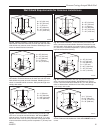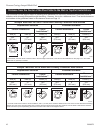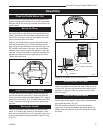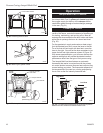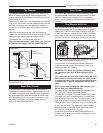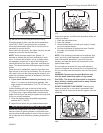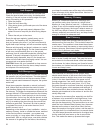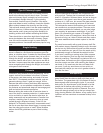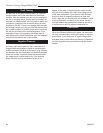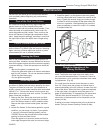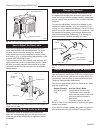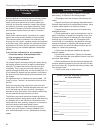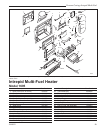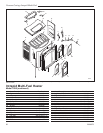
23
Vermont Castings Intrepid Multi-Fuel
2000970
Pipe & Chimney Layout
Every turn the smoke must take in its travel from the
stove to the chimney top will slow it down. The ideal
pipe and chimney layout is straight up from the stove,
to a completely straight chimney. If you’re starting
from scratch, use this layout if possible. If the stove-
pipe must elbow to enter a chimney, locate the thimble
about midway between the stove top and the ceiling.
This achieves several goals: it lets the smoke speed up
before it must turn, it leaves some pipe in the room for
heat transfer, and it gives you long-term flexibility for
installing a taller stove without relocating the thimble.
There should be no more than eight feet of single-wall
stove pipe between the stove and a chimney; longer
runs can cool the smoke enough to cause draft and
creosote problems. Use double-wall stove pipe for long
runs.
Single Venting
Each ‘airtight’ stove requires its own flue. If an airtight
stove is vented to a flue that also serves an open fire-
place, or a leakier stove, it’s easier for the chimney draft
to pull air in through those channels than it is to pull air
through the airtight, and performance suffers. Imagine
a vacuum cleaner with a hole in the hose to see the ef-
fect here. In some cases the other appliance can even
cause a negative draft through the airtight, and result in
a dangerous draft reversal.
Creosote
Creosote is a by-product of slow woodburning. It’s an
organic tar that can condense in the flue if it’s dense
in the smoke, and slow-moving, and cools off to less
than 290° F. Condensed creosote is volatile, and can
generate chimney fires if it gets hot enough. All the
features that affect chimney draft also affect creosote
condensation - so use whatever combination of installa-
tion features and operational steps will encourage good
draft and minimize creosote production.
Because letting the smoke cool off and slow down is
one of the keys to creosote production, it makes sense
to line a chimney to match the stove’s outlet size, for
safety reasons as well as performance. Canadian law
requires a matching liner to serve any stove or insert
vented through a fireplace chimney; in the US, the
National Fire Protection Association recommends one if
the flue is more than three times bigger (in square area)
than the outlet on the stove or insert. Some localities
enforce the NFPA guidelines as part of their building
codes.
Fuel
Even the best stove installation will not perform well
with poor fuel. The best fuel is hardwood that has air-
dried 12-18 months. Softwood burns, but not as long as
hardwood. Fairly ‘green’ wood has a good amount of
moisture in it; it will burn, but some of the heat potential
is used to drive the remaining moisture off the wood.
This reduces the amount that reaches your home and
can contribute to a creosote problem. There are mois-
ture meters available for firewood; you can also judge
your wood by its appearance and weight. If you get it
green, lift a piece and get a sense of its weight; it can
lose a third or more of its weight as it dries. Also look at
the ends of a log; as it dries it shrinks and often cracks.
The more weathered and cracked a piece is, the drier
it is.
Dry wood burns readily with a good chimney draft. But
with modern stoves, especially catalytic ones, the wood
can be too dry. While extra-dry wood has little creosote
in it, the remainder can ‘gas out’ from the wood quickly
and densely enough to overload the catalytic burner.
If you hear a rumbling or roaring noise, like a propane
torch, from the stove, that is a sign that the catalyst is
seriously overfiring. The catalyst is a platinum film on a
ceramic base; the metal can get to higher temperatures
than the ceramic can take, and overfiring the catalyst
can break it. Dry wood can also burn out faster than
you want. If your dry wood burns out too quickly or
overloads the catalyst you can mix in greener wood to
slow the fire down.
Backpuffing
Back-puffing results when the fire produces volatile
gases faster than the chimney draft pulls them out of
the firebox. The gases back up in the firebox till they’re
dense enough and hot enough to ignite. If your stove
back-puffs, you should open up the damper to let the
smoke rise to the flue more quickly, let more air into
the firebox, and avoid big loads of firewood. Run your
stove with enough primary air so that you always see
lively, dancing flames in the firebox; a lazy, smoky fire is
inefficient and can contribute to creosote buildup in the
chimney.



